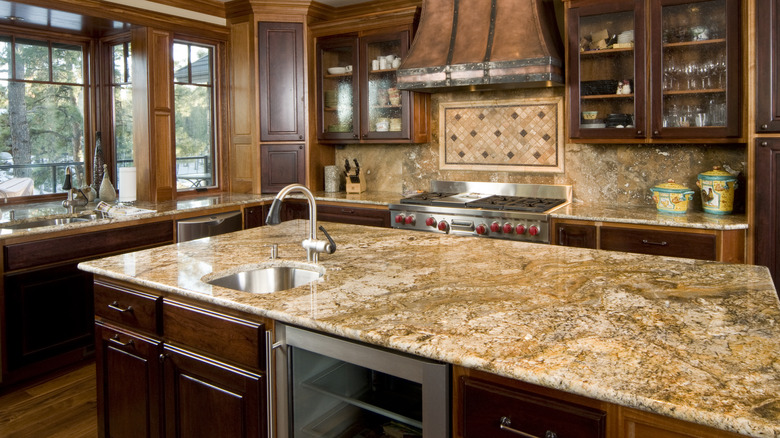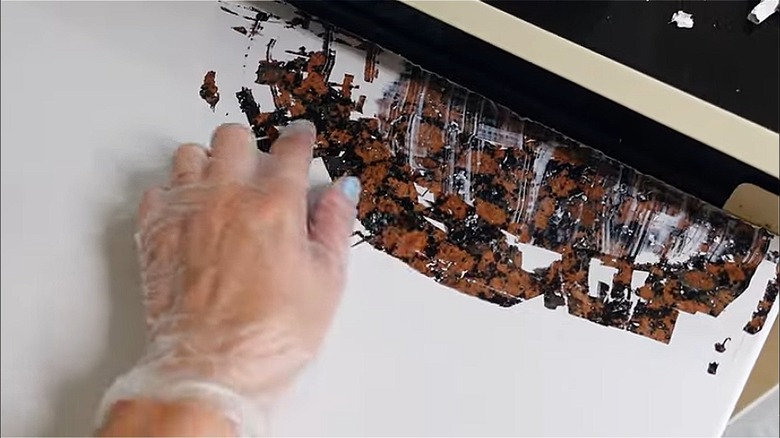Can You Paint Your Dated Granite Countertops To Redesign Your Kitchen?
We know that certain colors of granite can feel dated. Sometimes homeowners get in a fury about their orange and black granite countertops, wanting to change them immediately because they don't look contemporary. Unfortunately, some fling themselves into a fevered, under-researched paint job. They've gained confidence from painting rooms in their house or wood furniture, but don't know what they're actually in for. Yes, you can paint your granite countertops if you're a supremely experienced DIYer. But that fever to de-orange your kitchen could turn into a giant headache because of everything that can go wrong, like chipping and poor durability — we don't recommend painting over granite.
The impulse to redo your kitchen, island, or bar countertops is understandable. There are lots of reasons: it's simply the wrong color, your tastes have changed, your partner hates it, or you want a fresh look and new stone is just too expensive. Painting can cure many ills in a home so it seems like it could be a low-cost, low-risk option that guarantees a different look. But don't be fooled, it's a high-risk endeavor.
Here's what's involved and why it's risky
You already know Painting 101. Sand first, use a primer, get the right paint or stain for the job, and if it's furniture or flooring, it also needs to be sealed properly. Since that's the same basic procedure you'd follow when painting a countertop, what's the big deal? Well, some homeowners skip both the sanding and the priming. For the paint to stick, you need to roughen the stone's skating rink surface with an electric sander or use a hard-to-manage bottle of chemicals to etch the surface. You can't miss one centimeter of surface area. The caulk needs to be removed, the entire surface cleaned with a degreasing soap, and rinsed like there's no tomorrow. One spot of soap and the paint won't adhere.
It's imperative to get paint specifically formulated for countertops otherwise it will disintegrate. But you're likely to run into that anyway because a painted surface subjected to daily use will not be as durable as a slab of rock built to repel stains, scratches, and heat. Another area full of pitfalls is the sealing process. People either don't know they need to apply a sealer, apply the wrong one (like a sealer used for floors), or use the correct food-safe sealer that's so thick and gluey that it's peppered with brush strokes and bubbles. After all that work, it won't be water-resistant and the paint will eventually flake off.
What can you do instead of painting your granite?
If you can deal with the color, you can update old granite without paint through honing, a process of buzzing away imperfections to create a more subdued, matte finish. You may wonder what your other options are, especially if replacing granite with quartz or some other surface isn't attainable right now. Well, sometimes you can address the busyness of the granite pattern less directly. Maybe it's a good time to swap out the backsplash for one that's quieter, both in design and color. These long porcelain tiles from Backsplash ($32 per sheet) are unusual yet simple, and their warm beige tone is calming.
If you take the approach of pulling down the "noise" everywhere else in your kitchen, that will work to quiet down the sense of movement springing from your countertop. Although it's disruptive and expensive to get your kitchen cabinets painted, that could be another option. You could take the same approach and opt for a quiet color and even replace the hardware so it's monochromatic and matches the new paint color. To get started with ideas, this Greige color from Clare ($70 per gallon) is a pleasing neutral.

